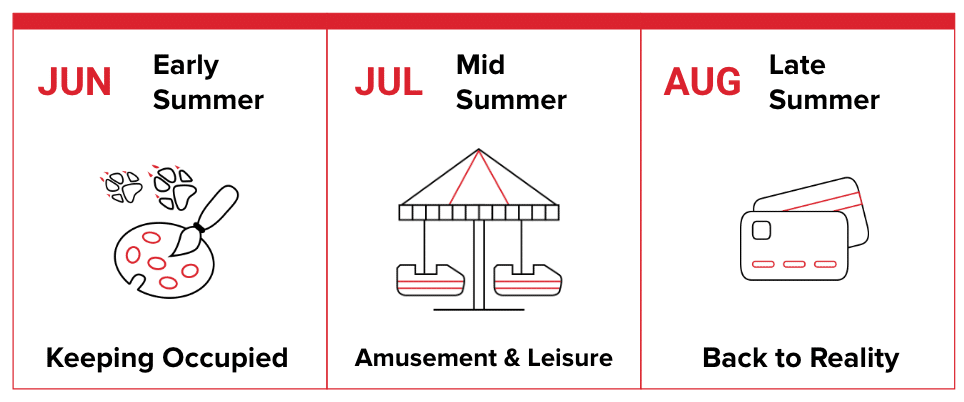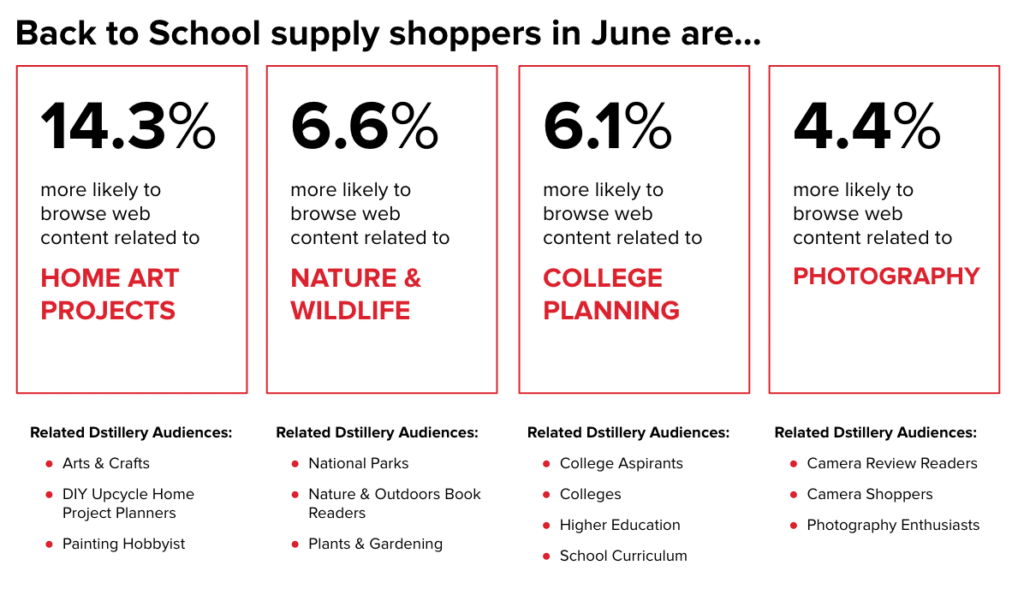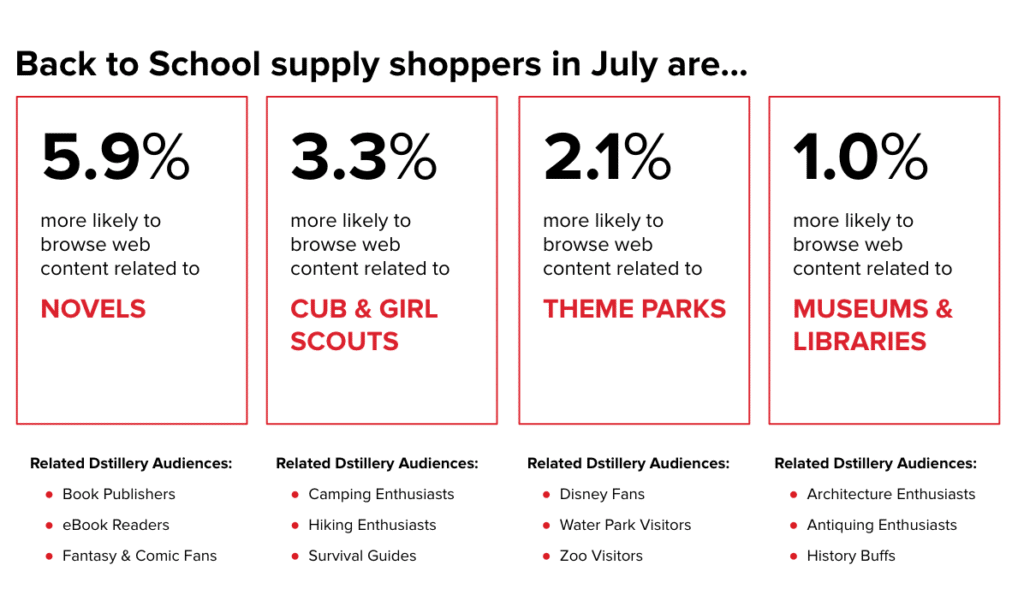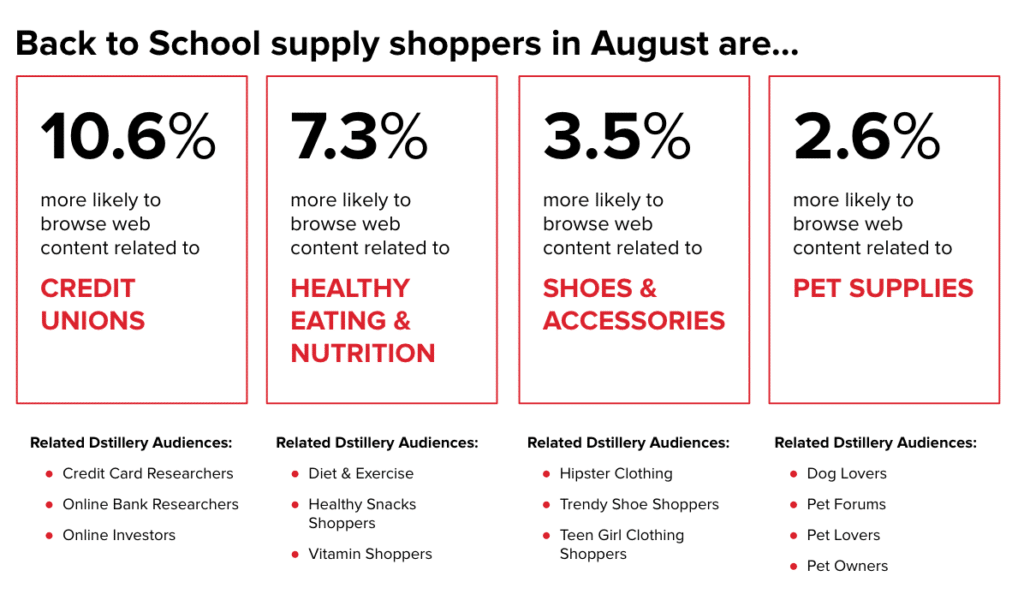I Know What You Did Last Summer: Getting Smarter About Reaching Back to School Shoppers
The end of the school year marks a time for relaxing with friends, exploring new destinations, and…shopping for school supplies. Huh? After nine months of early-morning wake up calls, packing lunches, and chasing school buses, the last place one might think to find a parent in the summertime is at a retailer looking for school supplies. Yet, savvy families know that they must start early to find bargain deals on supplies for the next school year. In a 2018 survey conducted by the National Retail Federation, 41% of families reported starting to shop for school supplies three weeks to one month prior to the school year and a whopping 25% of families reported beginning their search for school supplies a full two months prior to the start of the school year.
So Back to School shopping is really more of a season-long affair–far from the jam-packed week of last minute shopping before the first day of school.
What this means for marketers: reaching Back to School shoppers effectively requires paying special attention to how seasonality influences Back to School shopper behavior. In designing targeting strategies, marketers can no longer simply rely on indiscriminately advertising half-off promotions a few weeks prior to the beginning of the school year. This strategy may work fine when the school year looms close, but what about before then?
Here, we set out on a quest for smarter Back to School marketing by analyzing how their behaviors evolve throughout the summer.
THE THREE STAGES OF SUMMER
Early, Mid and Late Summer mindsets of Back to School shoppers

Our analysis revealed that Back to School shoppers experience three distinct mindsets throughout the summer: Keeping Occupied, Amusement & Leisure, and Back to Reality. Each of these mindsets are characterized by different browsing habits and activity preferences.
Below, we dive further into the distinct characteristics of these different mindsets and unpack what drives them to shop. Using these findings, we provide a blueprint for how retailers can use seasonal changes in shopper behavior to their advantage, helping ensure they reach Back to School consumers with messaging that resonates and products that best fit their needs.
EARLY SUMMER: KEEPING OCCUPIED
Exploring ways to make constructive use of the newfound free time.
With students facing nearly three months of unstructured free time following nine months of a jam-packed school schedule, parents are looking for ways to help their kids occupy their time productively. Between picking up a hobby, experiencing the great outdoors, and preparing for life after K12 there is no shortage of ways to stave off an idle mind.

To reach incremental Back to School shoppers in June, we recommend targeting segments related to Home Art Projects, Nature & Wildlife, College Planning, and Photography.
MID SUMMER: AMUSEMENT & LEISURE
Researching leisure activities, summer reads, and children’s summer programs.
A few weeks into summer, things have slowed down considerably. The regiments of the school year are a distant memory, instead replaced with a light & breezy air. In this atmosphere, parents are planning family excursions, picking up new leisure reads, and arranging fun activities for their kids.

To reach incremental Back to School shoppers in July, we recommend targeting segments related to Novels, Cub & Girl Scouts, Theme Parks, and Museums & Libraries.
LATE SUMMER: BACK TO REALITY
Cutting back indulgence and dealing with practical matters.
Alas, the impending school year begins to rear its head. It’s time to review the family budget, start buying vegetables again, and stock up on household items in bulk. And what do you know! The kids grew four inches in four weeks. This calls for a journey to the mall to update their wardrobe.

To reach incremental Back to School shoppers in August, we recommend targeting segments related to Credit Unions, Healthy Eating & Nutrition, Shoes & Accessories, and Pet Supplies.
CONCLUSION
Our findings illuminate the importance of taking seasonal context into account when planning Back to School marketing activations. For any marketer seeking to engage Back to School shoppers, understanding how their behaviors shift at different stages of the summer enables more effective marketing activations. These temporal insights can inform changes in how retailers market their products and help reach incremental audiences.
For example, knowing that Back to School shoppers show a higher likelihood to browse College Planning sites in June and Healthy Eating sites in August, retailers such as Staples can form creative, data-backed strategies to sell more products. Let’s use notebooks to illustrate this idea. In June, target College Aspirants, College Planning, and Parents of High School Students audiences with a messaging touting notebooks as an essential resource for capturing thoughts during college visits or studying for college prep exams. Then, in August, target Nutrition Conscious Eaters, Dieters, and Healthy Eating Researchers promoting notebooks as a valuable tool for anyone trying to make a healthy lifestyle change, perhaps serving as a food journal to keep them accountable.
Key Takeaway: Analyzing past seasonal patterns allows marketers to anticipate behavioral changes of their target audience, rather than react to them. Don’t let the Back to School season sneak up on you like a pop quiz – if you study your shoppers over time, your marketing plan will pass with flying colors.
If you’re interested in learning more about our Back to School shopper audiences for your campaign, contact us at contact@dstillery.com.


